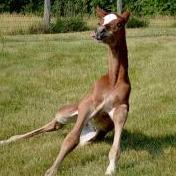All Activity
- Past hour
-
Forgive me dikman if I'm teaching granny to suck eggs but I can't help myself if I see a way to help someone. A few thoughts. If you run a disc cutter down the web of the angle iron but not all the way through will allow you to the angle gradually until you get it where you want, Bear in mind if you use an over angle you can always stop before fully closing. The one I showed above is 60 degrees. I do have a 90 degree but ill often use the 60 for this reason. Are you planning on welding or a wooden core? If wooden you have to think about getting the leather out. This can be a hole that you can poke through or you can glue some foam rubber under the core that will automatically eject the leather after cutting it. If using foam make sure that after leaving enough knife below the core to cut your thickest leather, you might need slightly more to allow for the compressed foam. You can use thin foam and glue on extra layers until it does the job If using wood cut slight smaller to allow for the thickness of the knife. Bear in mind the screws will help with slight anomalies. If welding you'll need an accurate (paper pattern) to test on as you bend If using wood and it finishes flush with the top of the knife it'll be robust enough to walk around some quite big patterns under the press. Looking forward to seeing your first makings from your own dies.
-
Regarding the glueing of hides. Don Gonzales published an interesting-to-me video on glue strengths. The Aquilim 315 water-based contact cement produced a strong bond when applied to one surface and immediately assembled without drying. I use Barge but think I'll give this a try. I like cutting straps one at a time so I can check the quality and decide how to use each strap.
- Today
-
I'm within a degree or two of a right angle! I used the mill to square up the inside of the first angle iron bender and cut the excess off the sides as looking at toxo's video it's obvious it doesn't need to be big. A bit more work with a triangular file to deepen it and change the angle a little bit should do it (stupid camera has a focus problem!).
-
Laser-engraved leather patches give hats a clean and stylish look.
- 16 replies
-
Hello, Im interested to learn if anyone has a source for saddle trees they are happy with? thanks, Jonathan
-
Thank you Double K! Yes, you understood my question correctly and your explanation/advise was very helpful. Thank you!
-
That kind of thickness stacked - a plough gauge slight maybe but eat a good breakfast, a draw gauge - better have a grip on the strap and the gauge and a sharp a*s blade. I'm not sure how far you are from any draft or pulling harness makers because I don't think we have any on the forum. I would get with one of those guys and ask how they do it. I'm betting one piece at a time and then stack them though.
-
The perfect oval punch.
DoubleKCustomLeathercraft replied to bsshog40's topic in Leatherwork Conversation
I know you ended up buying something since the original post. But for future reference. Weaver make a 1¾" trace punch which is perfect for holster slots. They're spendy, $205. I make a ton of holsters. I should really consider investing in one myself, but I'm a cheapa** 😆 -
Fortunately I've only had two real bad cases of over oiling. I tried kitty litter and corn starch. Neither worked. Never removed a bit of oil
-

Veg tan tooling with chrome tan projects
fredk replied to Blitz Thunderlungs's topic in How Do I Do That?
I'd stay with basic brown. Chrome tan pre-dyed in brown and veg tan accents dyed any shade of brown -
I had a costumer that wanted a new belt with his nickname and some tooling on it. I primarily make holsters and I'll cut a few straps for belts out of a side before I go to town on holster making. Well I ran out if belt straps quicker than I did the rest of the side, and didn't need or want to down 330 bucks on a side right now since I'm stocked up with what I need. I went onto weaver's site and found that they're selling Hermann Oak English bridle belt straps, which are veg tanned. It took me awhile to find the information here on how to properly case bridle leather. It's not the same as HO strap or holster tanned sides at all. I soaked the strap, left it in the fridge overnight like I would with regular veg tan. All that did was make it super stiff almost frozen feeling almost frozen. I did since more digging on the site here, and asked for input. Figured out that because of the waxes and oils in English bridle, cold is not what you want. Heat. Some say heat the tools, others say use a great gun on the strap. It's been warm, so i left it overnight again soaked. Pulled it out the next morning and it felt like I expected it to the first time. Left it hanging for about an hour to dry to the right moisture feel and went to town. It's harder to tool than any leather I've worked with, but I'm the end I think it all worked out great. I don't think I'll tool English bridle again though. It's a nice belt, great feel but not different enough to justify the extra hours to tool
-
The centre. Personally I am more hands on then my example. I hand cut my leather with a utility knife, use a standard oblong, round or corner punch with a hammer but I do use templates when I can and I do use a sewing machine as I don't have the temperament needed to sew by hand. Since I am artistically challenged I will use an embosser once I complete building it. To me hand sewn is literally when needles and thread are used manually to create a seam not a sewing machine. kgg
-
Strap construction and stitch alignment
DoubleKCustomLeathercraft replied to JZC's topic in How Do I Do That?
I'm having trouble understanding exactly what you're asking. You are attaching a leather billet as a loop to a strap? This billet is looped through the bag slot, and back to the strap with both ends sandwich said strap? If this is the case, I would stitch the section that's looped and not attached to the start first. That way you're not stitching the loop closed or having to deal with a tight area that regular needles are too long for. As for making the stitch look good on both sides. All I can say is punch your holes straight and perpendicular. They do have diamond stitching chisels are "backwards" so you can punch clean stitch holes from both sides of the project. You can use your awl also. I end up using my awl all the time because, and I hate it! Wish I had longer chisels but then they'd bend. It takes practice to get stitches straight front to back. What I do on something long like a belt is I'll use my 6 prong chisel, make sure I have it lined up so that it goes through evenly from the edge. Then I'll set 3 of those 6 prongs into the already punched stitches. This helps keep the tool at the same angle eliminating the misaligned stitch holes on the back side. That's what's worked for me to get front and back stitching that looks good in either direction. -
Veg tan tooling with chrome tan projects
kgg replied to Blitz Thunderlungs's topic in How Do I Do That?
What I would suggest is that you choose a colour for your chrome tan leather that will go with any colour you decide to use with your veg tan leather. Think of colours like black or grey or use a colour wheel. I wouldn't go with a leather stain as it will probably sit on top of the leather and rub off with use. kgg -
There are a number of suggestions if you care to search for them. Cornstarch, kitty litter, floor dry, etc. Bury the article in one of these. Keep stirring it around every few hours or days until it has absorbed how ever much it can. With all these suggestions, I haven't seen any confirmations from those that asked as to whether it works or not.
-
So I want to make some bible cases. Im ambitious and like to bite off more then I can chew. With that being said I want to do a nice tooled veg tan cover on the bible case with the rest of it thinner, softer chrome tan. What stain and what color chrome tan should I get to make these two different leathers look like they are the same project. Also I live 5 hrs away from the nearest leather supply store. I have to order everything online. Specifics will be appreciated.
- Yesterday
-
Ron’s Round and Montana Edgers
AndreasB replied to AndreasB's topic in Knives, Blades, & Things That Cut
@HideDesignsYes they are -
I've lost count of the number of videos I've watched on youtube to do with die making but that's the first time I've seen that one! More fettling to do (fortunately I enjoy it), I now know that my machine will work it's just a matter of making the right bending jigs and then finishing it off.
-
I need the button and spring for the stitch length adjustment....
-
Anyone Heard of a "Bind-All" binding machine?
hemiyota replied to hemiyota's topic in Leather Sewing Machines
Thanks, but it's gone!! -
Does this exclude a knife? These are all tools that we use. We don't stuff a hide into a machine and have a belt come out the other end. Some people have lots of tools that help speed up the process. Others have a minimal set of tools. Does it matter if I use a paint brush or an airbrush? They can produce practically identical products. If I call my work area a studio, does that move me into a different class than my basement or garage workshop? If I use a sewing machine versus manual needle and thread, it is hand sewn? If I guide the belt or what ever through the sewing machine, following the stitch line, or I saddle stitch, it is hand sewn? This example will get a lot of feedback. Which side of the bench do you sit on?
-
Soak it in denatured alcohol or acetone then wring it out & let dry. Best advice i can give.





.thumb.jpg.df03483a8f149b5c3635266f3ce9bbac.jpg)

.jpg.c9e6b26242b58785330330c8a6218284.jpg)
.jpg.a36c47e4ab6657b3e7941130d9e135f7.jpg)
.jpg.5bbfd1490aaa3478305a78c07b837b63.jpg)
.thumb.jpg.6e903dd66163ad5672f00f144058c571.jpg)